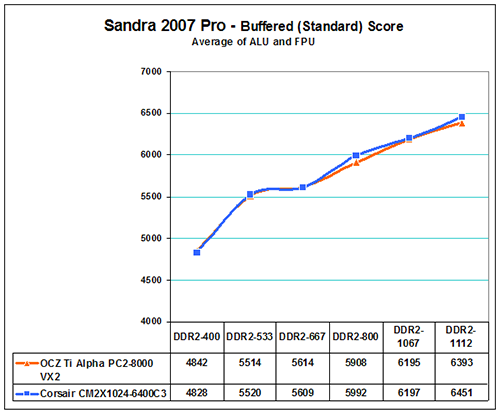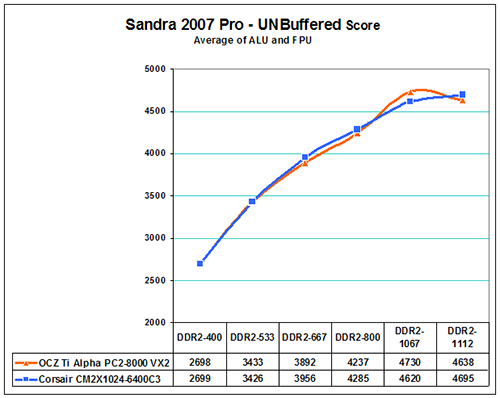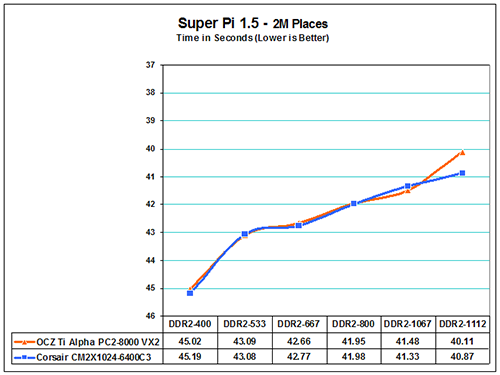Corsair and OCZ: New Standards in Fast DDR2
by Wesley Fink on August 4, 2006 5:50 AM EST- Posted in
- Memory
Memory Bandwidth and Scaling
Everyone should already know that memory bandwidth improves with increases in memory speed and reductions in memory timings. We first used the new Memory Performance Scaling charts in our comparison of DDR2 memory on AM2 and Core 2 Duo processors. They were so well-received the scaling charts will be used in future memory reviews to compare both Memory Bandwidth and Memory Performance over a wide range of DDR2 speeds. To evaluate memory bandwidth SiSoft Sandra 2007 Professional was used to provide a closer look at scaling.
Since the Corsair and OCZ results were so close at all tested speeds, the scale range was reduced to better show the small differences in these two memories. Please keep this in mind when viewing the charts, since a normal zero scale would make performance differences appear much smaller than these expanded scale charts. Values for each memory at each speed are included below each chart for reference.

The most widely reported Sandra score is the Standard or Buffered memory score. This benchmark takes into account the buffering schemes like MMX, SSE, SSE2, SSE3, and other buffering tools that are used to improve memory performance. We found in our recent AM2/NetBurst/Conroe comparison that AM2 provides the highest buffered bandwidth available - with leads at DDR2-800 as large as 40% over Conroe and NetBurst. NetBurst is next fastest, and Core 2 Duo provides the poorest Buffered bandwidth. Of course this does not carry through to other performance areas, as Core 2 Duo is normally 10% to 30% faster than AM2 or NetBurst in our system benchmarks.
Performance of the Corsair and OCZ are so close in Buffered bandwidth they could almost be from the same company.
As we have been saying for years, however, the Buffered benchmark does not correlate well with real performance in games on the same computer. For that reason, our memory bandwidth tests have always included an UNBuffered Sandra memory score. The UNBuffered result turns off the buffering schemes, and we have found the results correlate well with real-world performance.

In Unbuffered tests we see the Corsair 6400C3 and OCZ PC2-8000 again looking like they could be two samples off the same production line. Since both are based on specially binned Micron memory chips this should not be a real surprise.
The Sandra memory score is really made up of both read and write operations. It is also a synthetic benchmark that does not always reflect real world performance. We also compared pure number crunching with Version 1.5 of Super Pi - comparing the time to calculate 2 million places of Pi at the different memory speeds.

The most striking result in comparing Super Pi results is that performance continues to improve all the way to the highest speed that could be reached with stability - DDR2-1112 on both memories. The performance scaling illustrates how DIMMs with the same memory chips perform about the same. The only real difference between the Corsair and OCZ is the slightly better performance of Corsair at DDR2-1067 and the performance advantage of OCZ at DDR2-1112 - probably a result of the different approaches to SPD programming. Don't make much of these differences, however, as you can see similar difference in DIMMs coming off the same production line.
Everyone should already know that memory bandwidth improves with increases in memory speed and reductions in memory timings. We first used the new Memory Performance Scaling charts in our comparison of DDR2 memory on AM2 and Core 2 Duo processors. They were so well-received the scaling charts will be used in future memory reviews to compare both Memory Bandwidth and Memory Performance over a wide range of DDR2 speeds. To evaluate memory bandwidth SiSoft Sandra 2007 Professional was used to provide a closer look at scaling.
Since the Corsair and OCZ results were so close at all tested speeds, the scale range was reduced to better show the small differences in these two memories. Please keep this in mind when viewing the charts, since a normal zero scale would make performance differences appear much smaller than these expanded scale charts. Values for each memory at each speed are included below each chart for reference.

The most widely reported Sandra score is the Standard or Buffered memory score. This benchmark takes into account the buffering schemes like MMX, SSE, SSE2, SSE3, and other buffering tools that are used to improve memory performance. We found in our recent AM2/NetBurst/Conroe comparison that AM2 provides the highest buffered bandwidth available - with leads at DDR2-800 as large as 40% over Conroe and NetBurst. NetBurst is next fastest, and Core 2 Duo provides the poorest Buffered bandwidth. Of course this does not carry through to other performance areas, as Core 2 Duo is normally 10% to 30% faster than AM2 or NetBurst in our system benchmarks.
Performance of the Corsair and OCZ are so close in Buffered bandwidth they could almost be from the same company.
As we have been saying for years, however, the Buffered benchmark does not correlate well with real performance in games on the same computer. For that reason, our memory bandwidth tests have always included an UNBuffered Sandra memory score. The UNBuffered result turns off the buffering schemes, and we have found the results correlate well with real-world performance.

In Unbuffered tests we see the Corsair 6400C3 and OCZ PC2-8000 again looking like they could be two samples off the same production line. Since both are based on specially binned Micron memory chips this should not be a real surprise.
The Sandra memory score is really made up of both read and write operations. It is also a synthetic benchmark that does not always reflect real world performance. We also compared pure number crunching with Version 1.5 of Super Pi - comparing the time to calculate 2 million places of Pi at the different memory speeds.

The most striking result in comparing Super Pi results is that performance continues to improve all the way to the highest speed that could be reached with stability - DDR2-1112 on both memories. The performance scaling illustrates how DIMMs with the same memory chips perform about the same. The only real difference between the Corsair and OCZ is the slightly better performance of Corsair at DDR2-1067 and the performance advantage of OCZ at DDR2-1112 - probably a result of the different approaches to SPD programming. Don't make much of these differences, however, as you can see similar difference in DIMMs coming off the same production line.










18 Comments
View All Comments
epsilonparadox - Friday, August 4, 2006 - link
That also is your opinion. To me an elitist is someone who demands a higher standard that the common folk. An elitist to me in the computer industry is someone who buys items that he/she knows will raise the level of standards among his peers. The items this person purchases doesn't necessarily have to be the most expensive but usually demands a higher premium because of the proven value.yacoub - Friday, August 4, 2006 - link
Alas, labeling one an "elitist" has a distinctly negative connotation to it, and that is not an opinion, that is simply how it is (fact, if you will).So by discussing the term elitist, you further the point that those who seek the best bang for the buck are certainly not elitists in the commonly accepted sense. Not to mention your comment regarding a price premium also goes against the core ideology of the overclocker - ie, those who look for what is most cost-effective and NOT premiumly priced. Generally speaking they are items that (at least initially) are lesser-known and often rather cheap because their real potential is commonly unknown. If anything the nature of the overclocker is the opposite of your elitist, in that they are interested in taking common things and making them into superstars, instead of just buying premium-priced items that supposedly have better performance according to the manufacturer's marketing department.
rjm55 - Friday, August 4, 2006 - link
I want, therefore I have.araczynski - Friday, August 4, 2006 - link
thanks for a good read, i agree that the overclocking scale is looks like its designed by some marketing group, stop using that kind of junk.when shown in real scale those small differences are nothing.
jmke - Friday, August 4, 2006 - link
Would be cool to see the charts start at scale 0, which would show the rather small impact of overclocking/getting higher rated memory modules. With a scale starting close to the min. score, the increase shown in the chart is not quite realistically represented ;)Did you run into weird results with: DDR2 PC4200 low timings vs DDR2 PC5300 medium/high timings ?
Spacecomber - Friday, August 4, 2006 - link
Your comment beat me too it. I also was going to chide Anandtech for producing charts that dont have a scale starting from 0. You should stick to tables, if all you are trying to do is show the number of points difference between one speed to the next.Wesley Fink - Friday, August 4, 2006 - link
Tables are already included as a summary of results for each tested memory. The Corsir table is on page 4 and the OCZ on page 5. The charts are there to show the impact of memory speed scaling on performance, which is not well-illustrated in the table or in our common bar charts. We added a paragraph explaining that scales are reduced to better show the small differences in performance between these two memories.You are both right that charts using zero-based scales will make the differences appear smaller than the reduced scale charts, but we were trying to compare the small differences in the Corsair and OCZ. We do prefer zero-based charts and an explanation was definitely needed.
Googer - Saturday, August 5, 2006 - link
With the performance of these DIMMs being about the same it really comes down to price, warranty, and reliablity as the deciding factors when you are shopping for RAM.